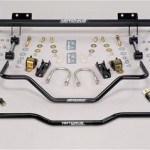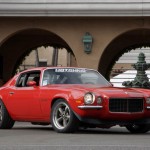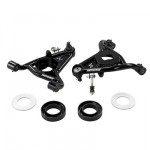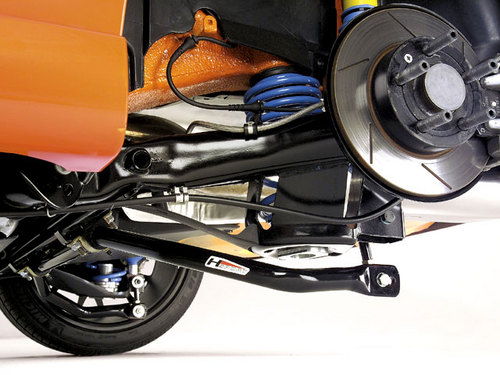For the average hot rod enthusiast, budget comes into play in a big way. We can’t spend the mortgage payment on a truck load of car parts, so we either save up or buy the parts we need individually as we can afford them. In this guest post, Mark Rossetti, sales manager at Hotchkis Sport Suspension, shows us how to improve our muscle car suspension on a real-world, average Joe budget:
Upgrading the suspension on a muscle car is a lot like building a house, you wouldn’t put the roof on before you’ve constructed the walls and the foundation. So where do you start?
If an enthusiast on a budget can’t afford all the parts at once, here is a recommended order for suspension upgrades.
Assuming the tie rod ends, ball joints, and other steering components are in good shape, we’d start to improve handling by replacing all the rubber suspension bushings with polyurethane bushings. The next upgrade would be a good sway bar.
 Most muscle cars came with a very small front sway bar and no rear bar at all. This design worked in the 1960s because the suspension wasn’t the limiting factor—the tires were. Factory 14 x 6 bias-ply tires would lose traction long before the suspension was maxed out, so a small bar was all you needed.
Most muscle cars came with a very small front sway bar and no rear bar at all. This design worked in the 1960s because the suspension wasn’t the limiting factor—the tires were. Factory 14 x 6 bias-ply tires would lose traction long before the suspension was maxed out, so a small bar was all you needed.
In the modern era of high performance radial tires with sticky compounds, upgrading to a larger high performance sway bar is one of the fastest, easiest and most cost-effective ways to improve handling and control on your muscle car. Tubular bars like the ones Hotchkis Sport Suspension offers are lighter than solid bars but have the same torsional rigidity due to increased diameter. This makes installation easier and improves front/rear weight balance.
 The next step would be lowering the center of gravity with a set of lowered coil springs or leaf springs. This not only looks cool, it also minimizes body roll and will help increase tire contact and overall driver control. Choosing the correct spring is often a difficult task as you will need enough spring rate to control the vehicle and keep it from bottoming out at it’s new height while still maintaining an acceptable ride. This process is often best left up to a suspension tuner like Hotchkis.
The next step would be lowering the center of gravity with a set of lowered coil springs or leaf springs. This not only looks cool, it also minimizes body roll and will help increase tire contact and overall driver control. Choosing the correct spring is often a difficult task as you will need enough spring rate to control the vehicle and keep it from bottoming out at it’s new height while still maintaining an acceptable ride. This process is often best left up to a suspension tuner like Hotchkis.
At this stage, shocks are also a critical upgrade. Nothing available over the counter at your local auto parts store is a true performance shock—despite what it may say on the box. Units like the HPS1000 Bilstein units offered by Hotchkis, as well as shocks from other high performance aftermarket companies, offer tuned performance that combine a decent ride with excellent balance and control.
For cars looking to improve traction, there are many options depending on the vehicle’s suspension style. For example, Chevelles, El Caminos, GTOs, Impalas, and many other GM vehicles use a four-link rear suspension. These factory components are prone to flex under load, which causes the suspension to lose traction, or hop. Upgraded trailing arms are an effective way to control wheel hop and improve traction and are typically a simple, remove-and-replace installation. Some models are adjustable, such as the trailing arm packages from Hotchkis Sport Suspension.
On leaf spring cars—Camaros, Novas, Mustangs, etc.—traction bars or specially designed leafs are often necessary to control wheel hop or traction. Factory leaf springs are designed for comfort, so they are soft which allows them to “wrap-up” and cause uncontrollable loss of traction while driving around corners and in a straight line. Good aftermarket springs such as the Hotchkis leaf springs are designed with more front bias, meaning the front portion of the leaf spring is more rigid, greatly reducing the chance of wheel-hop and increasing traction by controlling the rear axle.
Another commonly overlooked aspect of the suspension related to traction is shock absorbers. Once the vehicle starts to hop, the shock absorber needs to dampen or control the energy being generated; therefore good performance shocks are required.
 To further improve handling, consider tubular control arms. Most 1960s-era cars were designed around bias ply tires. Today’s modern radial tires require different suspension geometry to perform at their peak potential. Often, enthusiasts install wider, larger diameter wheel/tire packages and notice the car feels uncontrollable at times. Properly engineered tubular controls will increase caster for added vehicle stability and improve camber curve to help the tires maintain a bigger contact patch on the ground throughout the turn. This improves traction and overall handling.
To further improve handling, consider tubular control arms. Most 1960s-era cars were designed around bias ply tires. Today’s modern radial tires require different suspension geometry to perform at their peak potential. Often, enthusiasts install wider, larger diameter wheel/tire packages and notice the car feels uncontrollable at times. Properly engineered tubular controls will increase caster for added vehicle stability and improve camber curve to help the tires maintain a bigger contact patch on the ground throughout the turn. This improves traction and overall handling.
The final step to a well-balanced muscle car suspension is chassis bracing. Specific products vary by vehicle design, but common modifications are subframe connectors on uni-body cars and roll cages on full-frame vehicles. Effective chassis bracing will help tie all your suspension modifications together by increasing chassis rigidity and reducing vehicle flex. As an added bonus, installation of items like subframe connectors will many times help reduce body cracks or vehicle rattles due to flex.
What about kits? We’ve put together our Total Vehicle Systems to offer a tuned suspension solution for any vehicle. This gives you another option for building a well-balanced suspension.


Great story!
works for me.